Monemvasia Greece: Your Insider’s 2024 Travel Guide
Monemvasia Greece is arguably one of the most magical and breathtaking travel destinations in Southern Europe. In recent years, Monemvasia has soared in popularity as a romantic travel destination. In part, thanks to social media photography of its narrow passageways and medieval architecture.
Previously, Monemvasia was something of a hidden gem, known only among Greeks, and true Grecophiles. The castle town sits on the slopes of a rocky island, just off the eastern coast of the Peloponnese.
A Little History of Monemvasia, Greece
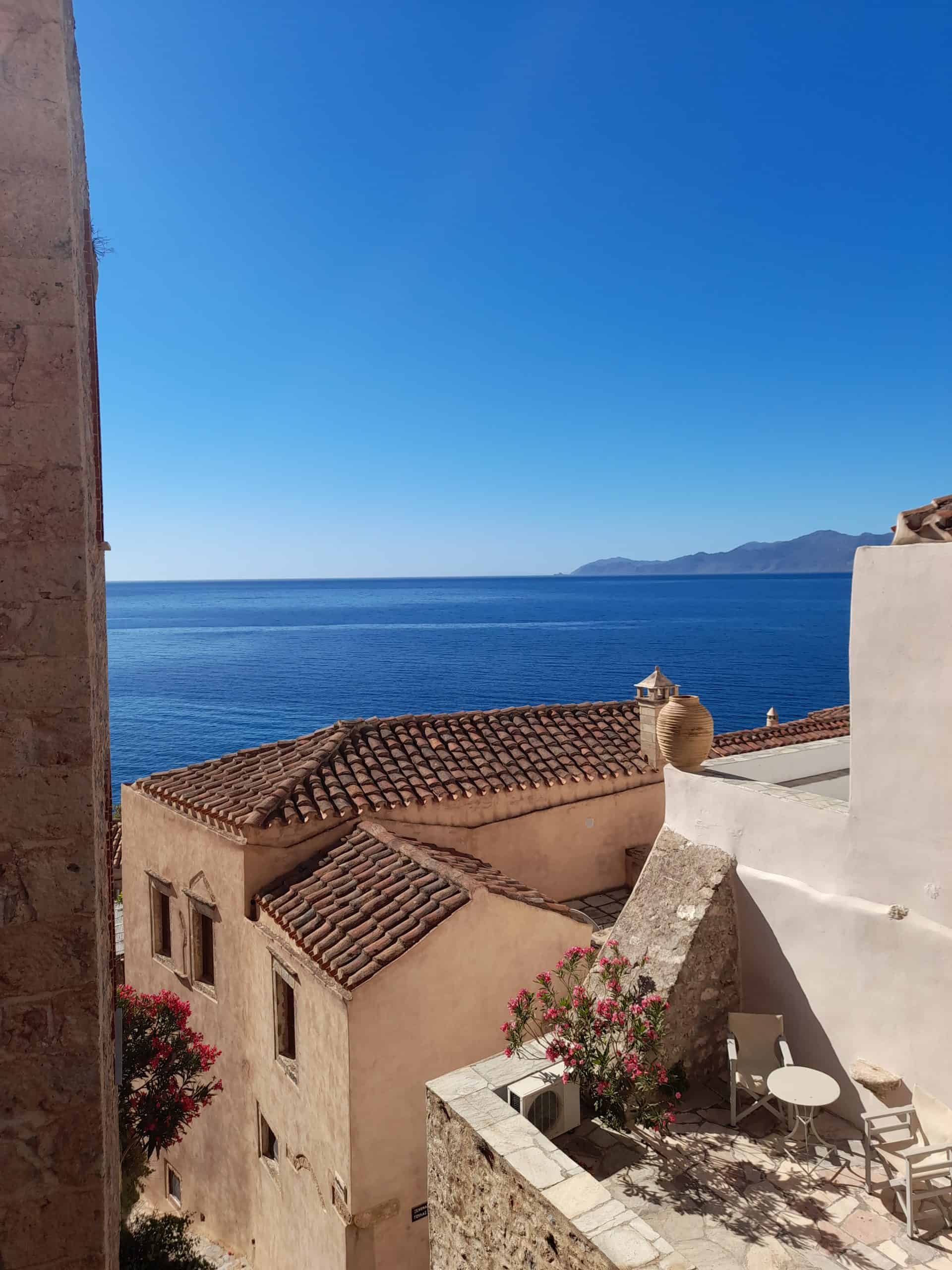
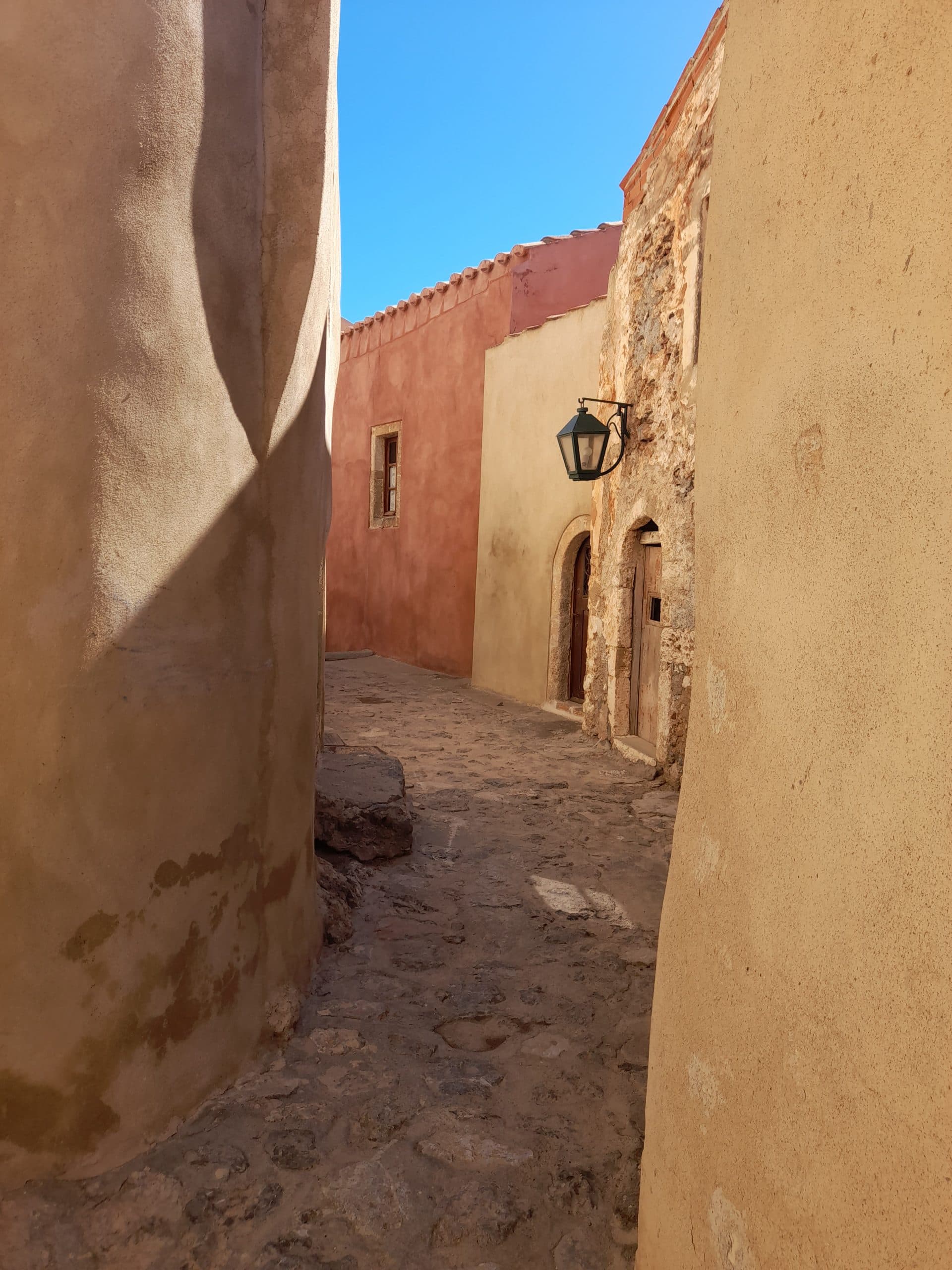
During medieval times, locals built Monemvasia by carving it straight into the rock that sits at the centre of the island. Today, the town is extremely well preserved, and travelling here feels like a journey back in time. Regardless of how many times you have seen photographs and video footage of the town, arriving here, and seeing it first hand for yourself will take your breath away.
Monemvasia’s hilltop island location was perfect for defensive purposes. A giant earthquake in 375 AD separated the rock of Monemvasia from the Greek mainland.
The original settlement dates back to the 6th century. At this time, residents of Ancient Laconia fled to Monemvasia in order to escape the Slavic invaders that occupied much of Greece.
It wasn’t until the 13th century that Monemvasia really began to thrive and develop. It was a very important Byzantine settlement, along with the nearby Laconia castle town of Mystras.
The settlement has been invaded and occupied by various civilisations throughout the years. The Venetians and the Ottomans have also left their mark on Monemvasia – resulting in a mishmash of architecture.
Exploring Monemvasia Greece
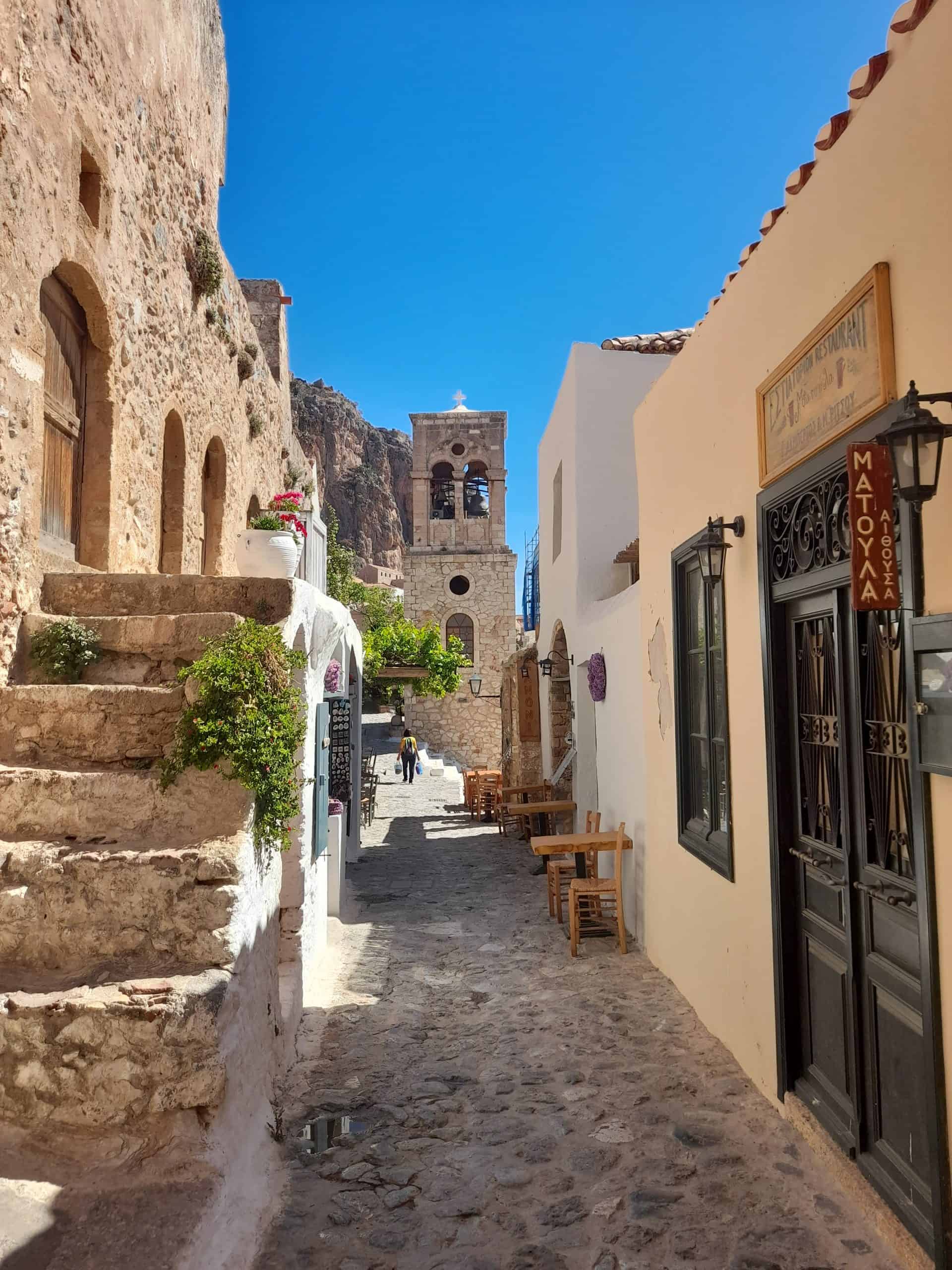
The medieval town of Monemvasia is essentially divided into two halves: the “lower town” and the “upper town”. Passing through the main entrance gate marks your arrival in Monemvasia lower town.
In the medieval era, this is where the “common folk” would live. The lower town mostly consisted of stores, blacksmiths, and common houses.
Plateia Dsami is the stunning main square of Monemvasia lower town. A mosque was constructed here during the Ottoman occupation and it still stands today.
Now, many of the buildings here have been converted into luxury boutique hotels, restaurants, coffee shops, and souvenir stores. The “lower town” is the best preserved part of Monemvasia.
Monemvasia’s “upper town” was once home to grand palaces and the houses of nobles. Today, it lies mostly in ruin.
Notable Sights of Monemvasia, Greece
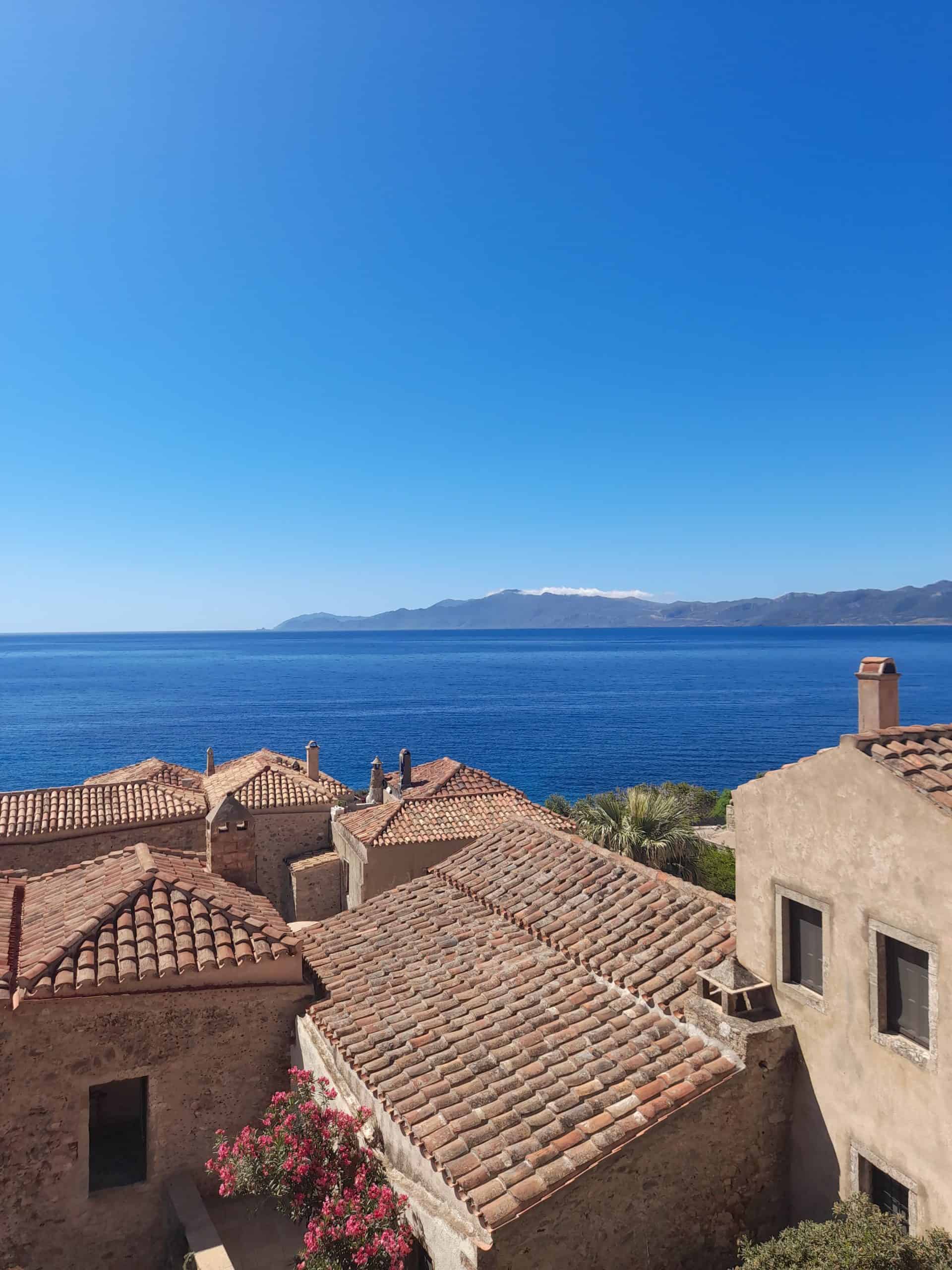
The main appeal of visiting Monemvasia is simply taking the time to get lost among the town’s narrow cobbled streets, sip Greek coffee in its panoramic cafes, and enjoying a little rest and relaxation at indulgent accommodations.
Monemvasia is essentially an open-air museum. As you meander around, you will stumble across former mosques, churches, and ruined houses. All of these spots have information plaques out front, enabling you to discover their history.
Plateia Dsami
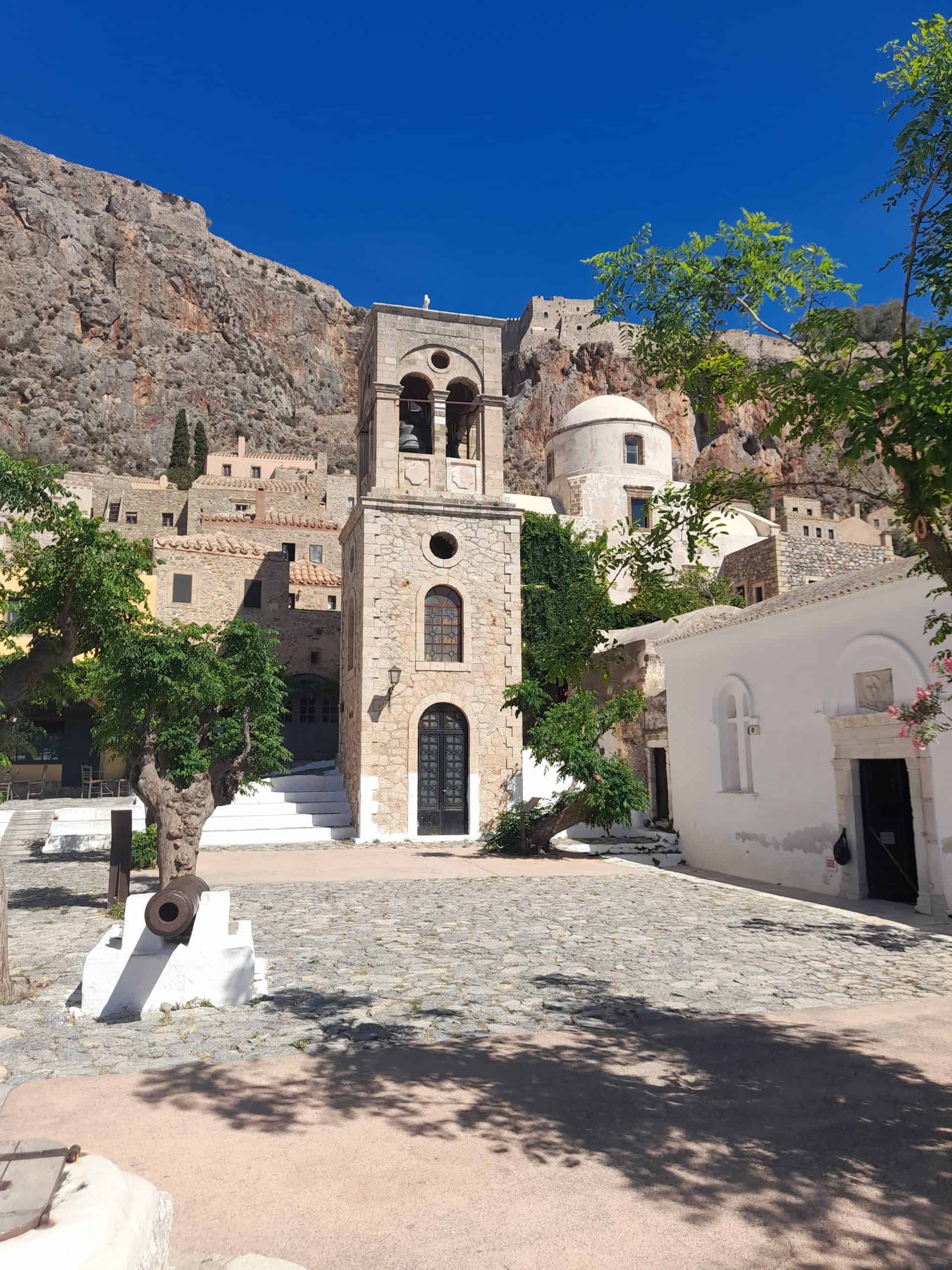
Plateia Dsami is the main square of Monemvasia. It is also sometimes referred to as “mosque square” on account of the disused mosque that still stands here from the days of the Ottoman occupation.
Quaint coffee shops and rooftop bars encircle the square. The former mosque now houses Monemvasia Archaeological Collection – an array of artefacts that have been excavated from Monemvasia and the surrounding area.
Entrance to the museum is 2 euros per person. The collection consists mainly of architectural sculptures and ceramic objects used in daily life. Outside, defensive cannons are still located along the city walls, as if continuing to guard it protectively.
The Church of Christ in Chains (Elkomenos Christos)
The Church of Christ in Chains (Elkmoneos Christos) is located within the charming Plateia Dsami. The church receives its obscure name on account of a rare icon that is found inside. This icon depicts an image of Jesus in chains before he was taken to the crucifix.
Churches occupy virtually every street corner in Greece. Monemvasia is no different. However, Elkomenos Christos is particularly picturesque on account of its stone clock tower.
An inscription at the church entrance indicates that it was constructed in 1697. Two thrones sit inside, dedicated to the Byzantine Emperor and Empress. The clock tower was added later, in 1801.
Plateia Chrysafitissa
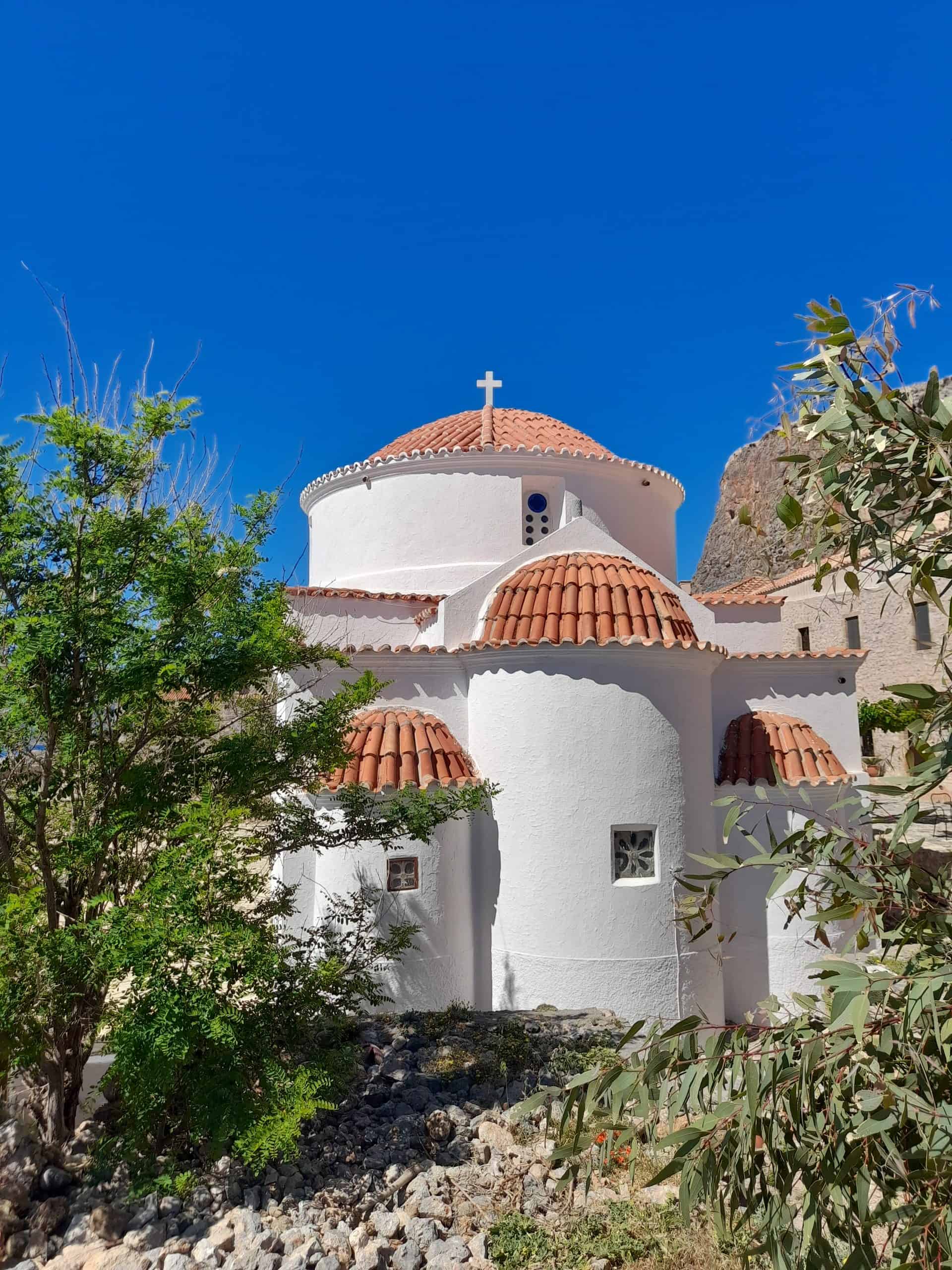
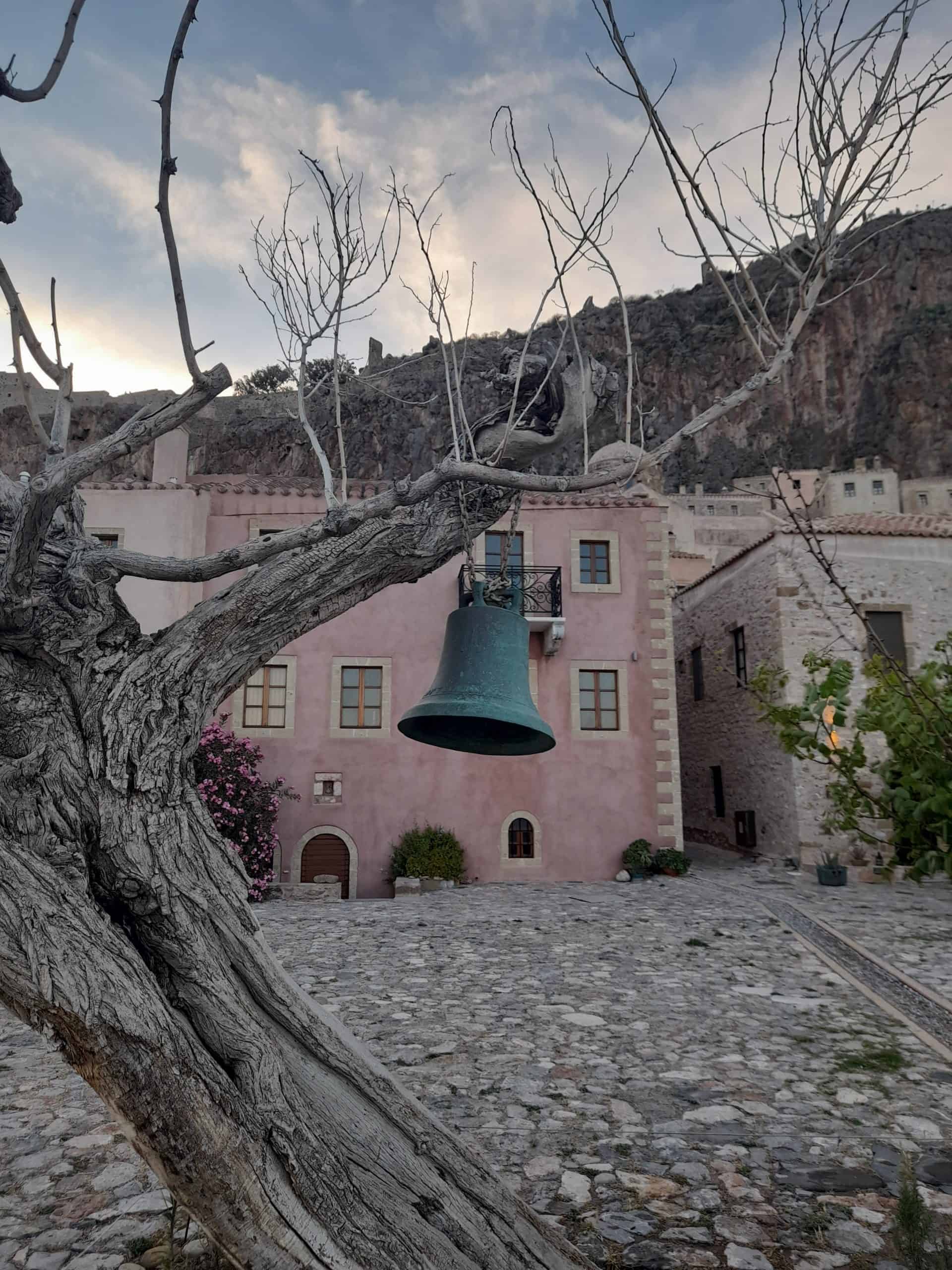
Plateia Chrysafitissa takes its name from the square’s resident Panagia Chrysafitissa Church. This sprawling courtyard sits at the far end of Monemvasia lower town.
Benches are scattered around this square, which is mostly filled with luxury hotels. They offer a perfect rest spot to enjoy the sweeping vistas over the Myrtoan sea.
A small passageway at the far end of the square leads you towards Monemvasia lighthouse. The gorgeous whitewashed church of Panagia Chrysafitissa dates back to the 17th century and still performs services to this day.
“Upper town” Ruins
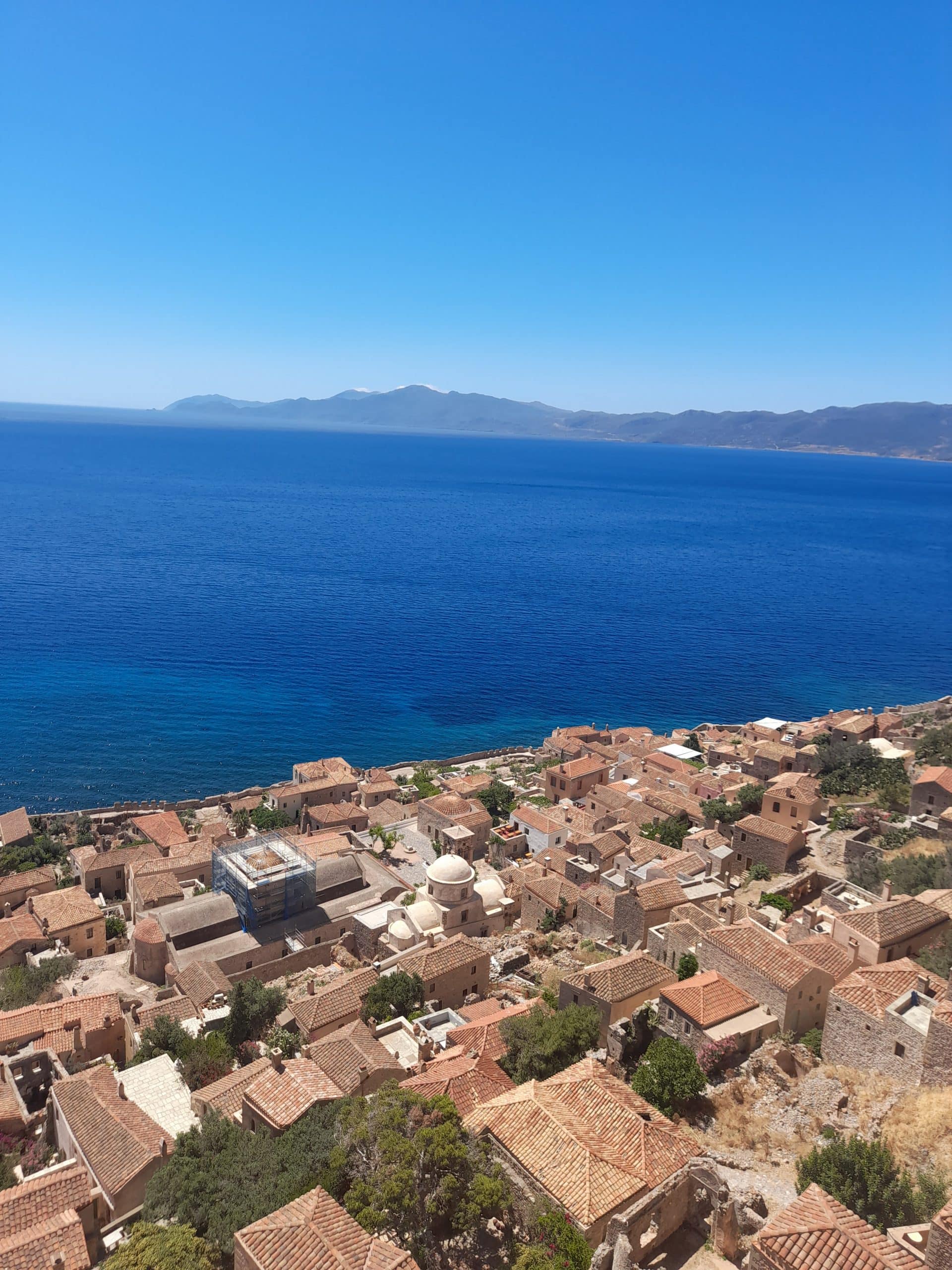
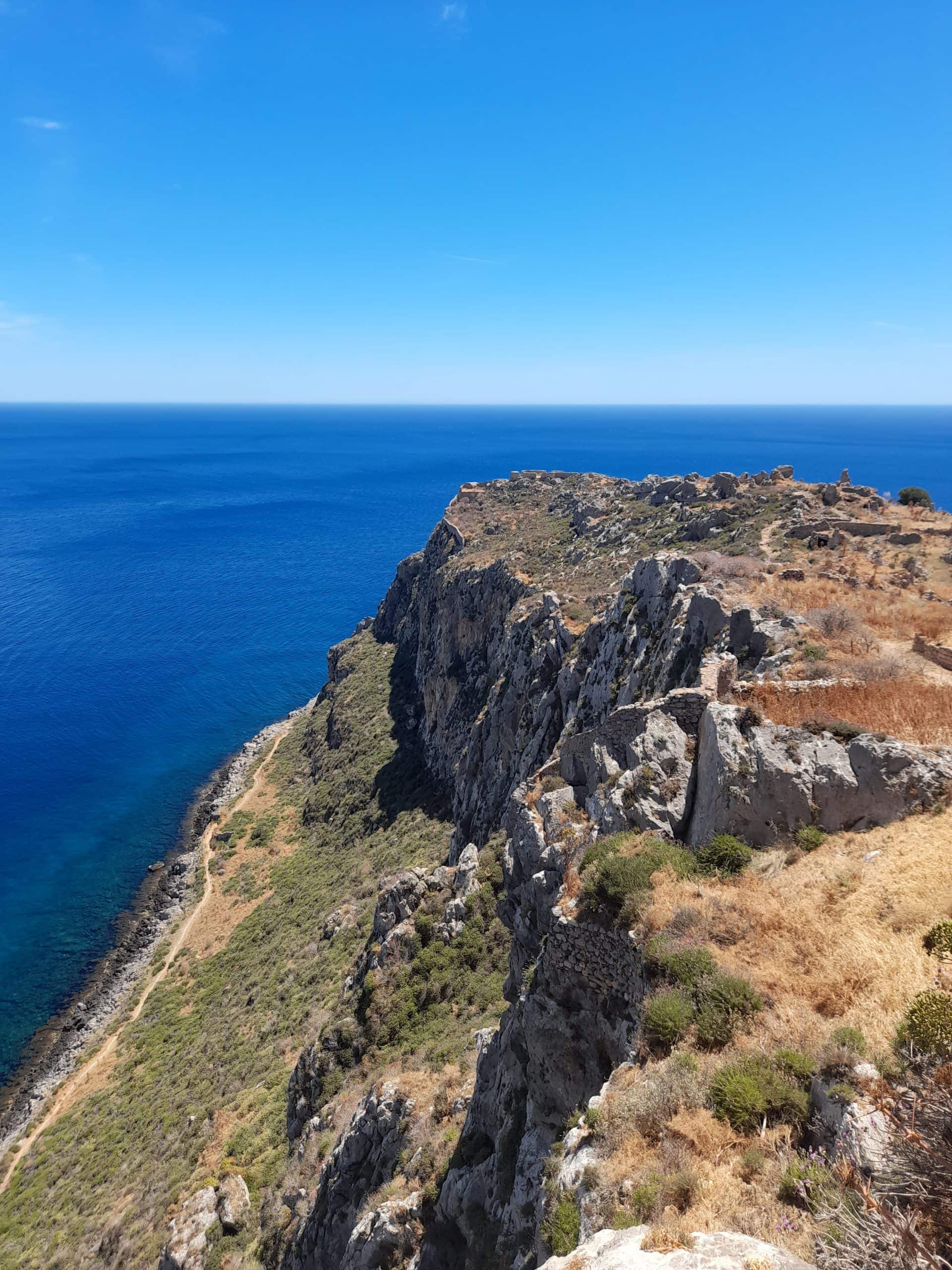
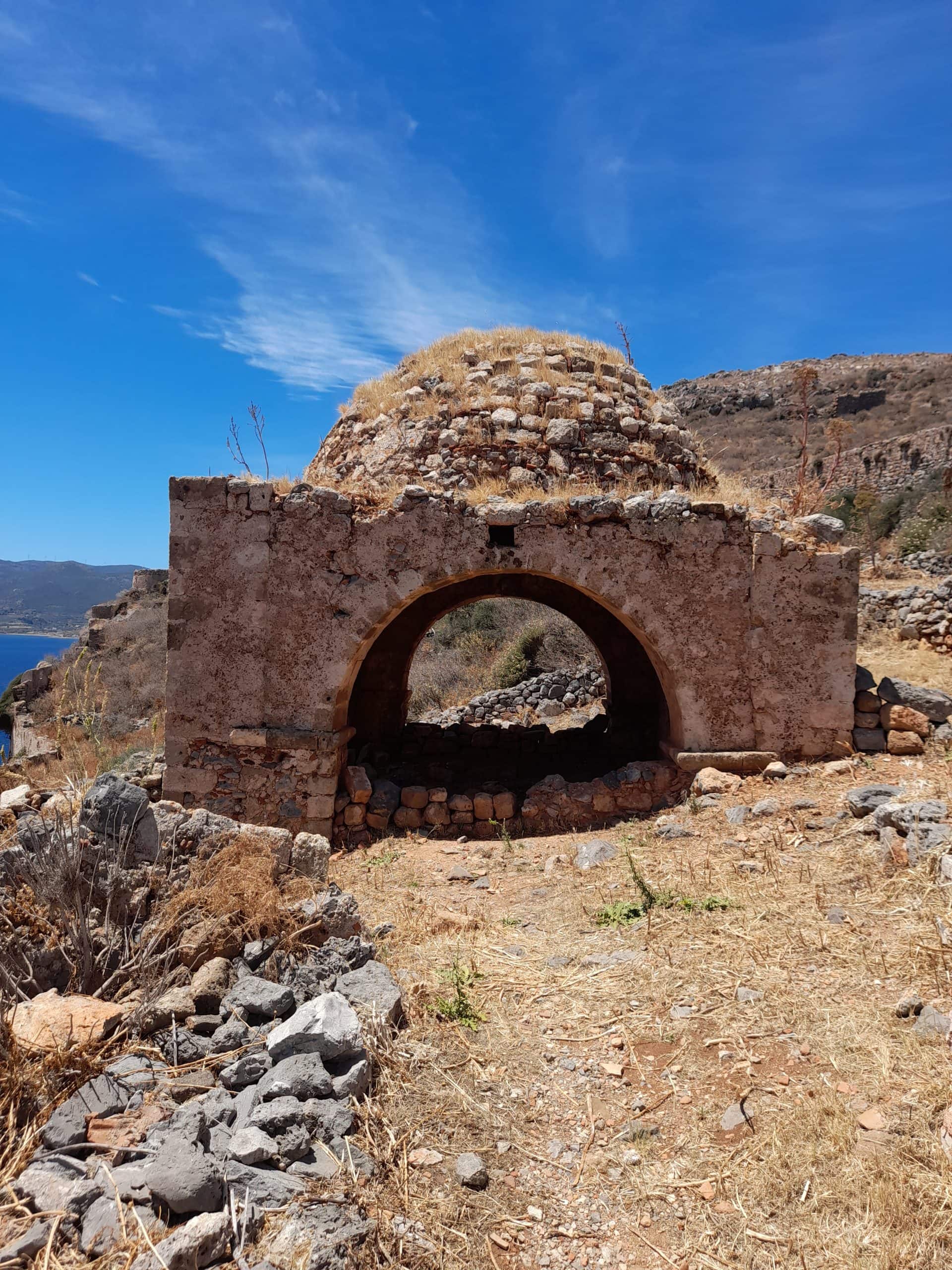
The walk to the upper town of Monemvasia is somewhat challenging but well worth the effort. From the base of Monemvasia hill, it looks as though the medieval castle is the only thing up here.
As a matter of fact, the upper town is a sprawling site consisting of old hammams, mosques, mausoleums, churches, and noble houses. You could easily spend over an hour exploring the ruins.
In its heyday in the 17th century, there were more than 500 grand mansions located up here, home to the local aristocracy. Today, all that remains are the crumbling sun bleached shells of old homes.
The former upper town is now largely overgrown. However, much of the flora and fauna that grows wild here is rare, making the area a botanical treasure trove perfect for nature lovers.
Church of Agia Sofia, Upper Town
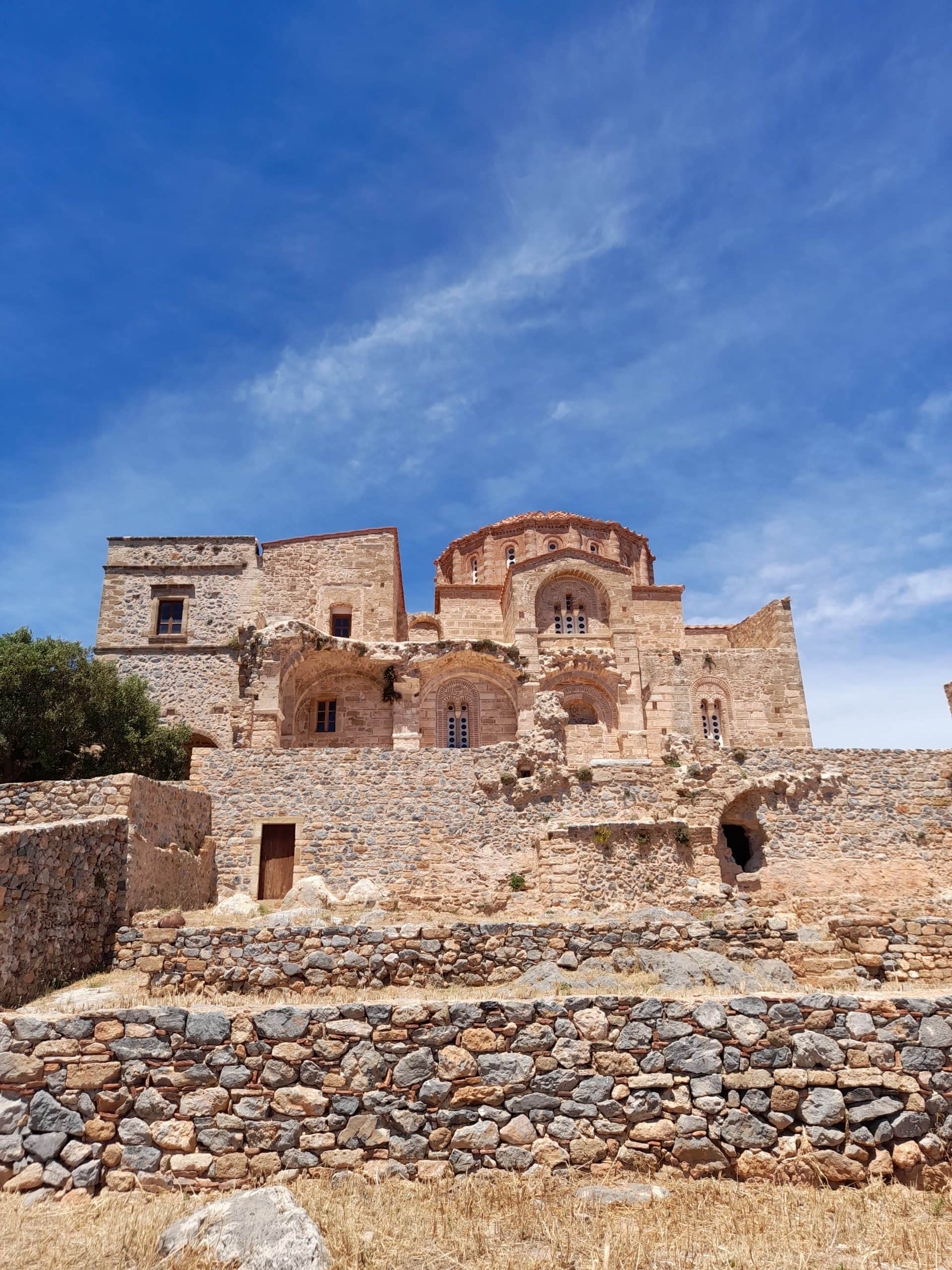
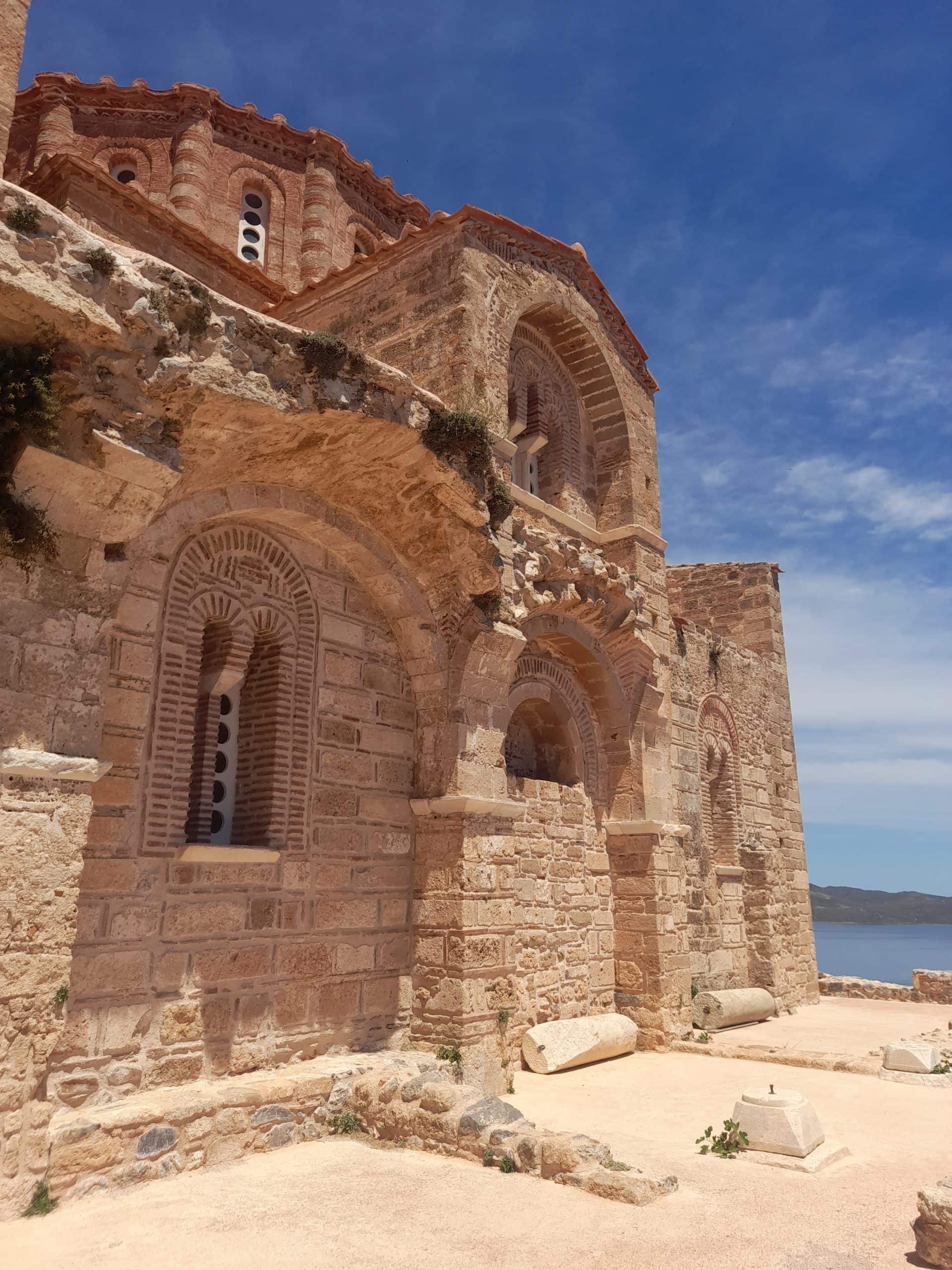
The church of Agia Sofia is the most impressive and best-preserved site in Monemvasia upper town. The building and its interior frescoes date back to the 12th century. It has served various religious faiths throughout the centuries.
This is among the oldest and most important Byzantine structures in Greece. The church’s location is as dramatic as its history is important.
Hagia Sophia is perched on the edge of a rocky cliff top. From here, you can enjoy incredible views out to sea.
Initially, the church was dedicated to the virgin Hodegetria. After the war of independence in 1821, it was dedicated to the Holy Wisdom of God, as it was considered to be a replica of the Hagia Sophia in Istanbul.
During the first Turkish rule (1540-1690), the church was converted into a mosque. A mihrab and a minaret were added. During the second Venetian rule, it functioned as a Catholic monastery, before being again converted into a mosque, and then finally, back to a Christian church.
The Monemvasia Lighthouse and Coastal Hike
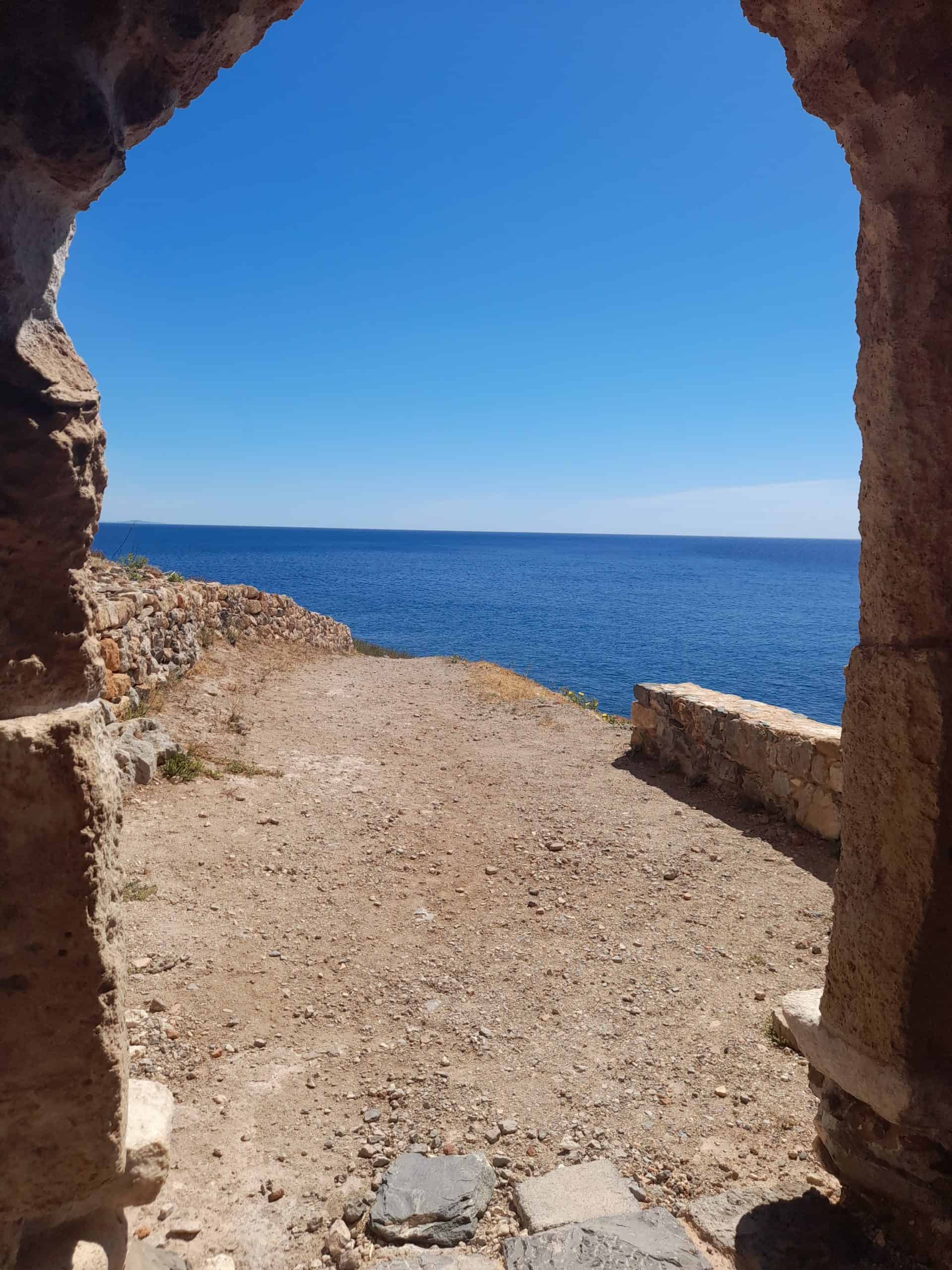
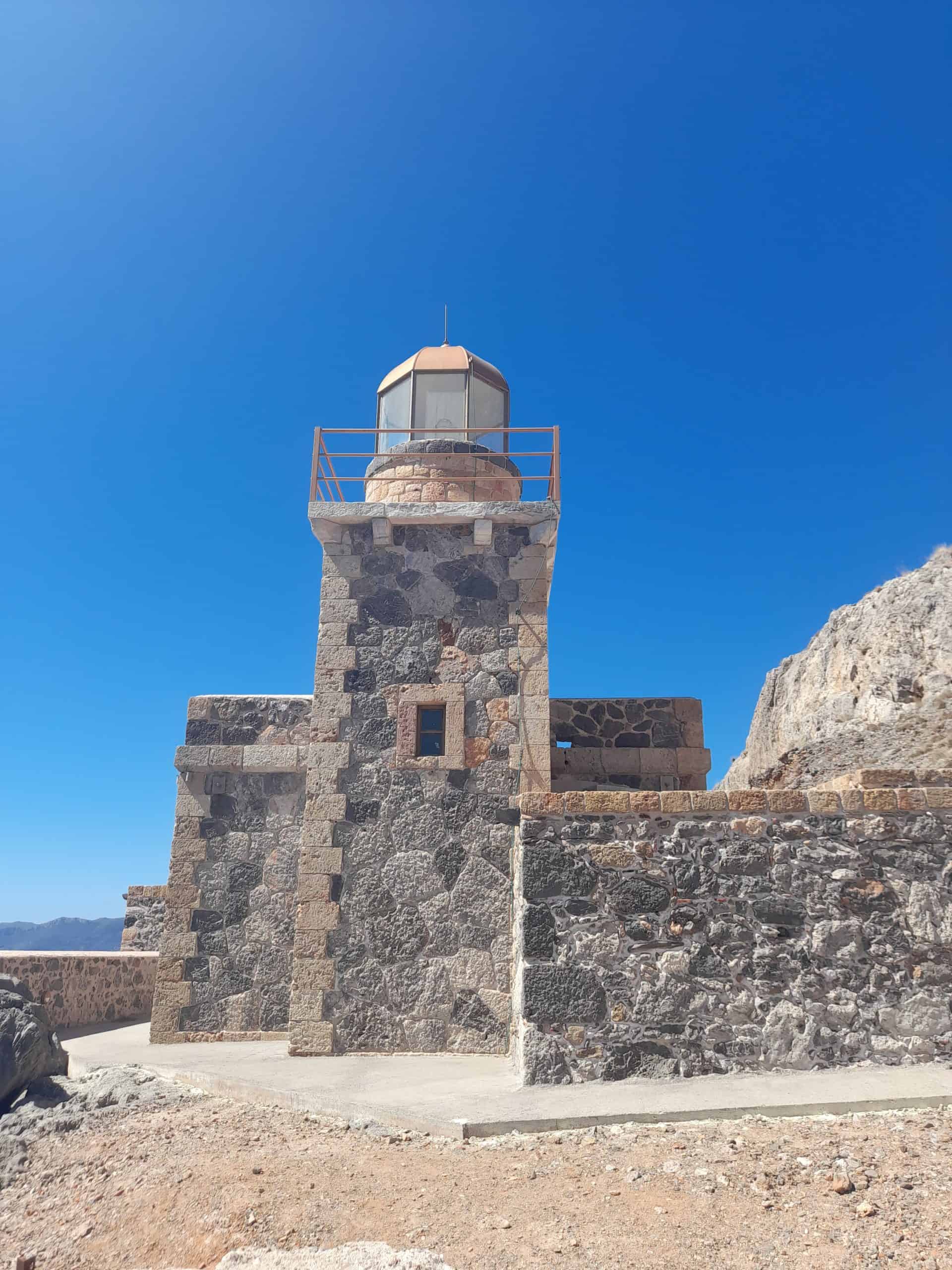
The Monemvasia lighthouse is one of the newer buildings constructed in the area. It was established in 1896 and automated in 1960.
There is a hiking trail that runs around the circumference of the island, passing by this gorgeous lighthouse. From Monemvasia lower town, follow the pathway that leads out of the walled city from Plateia Chrysafitissa,
Upon arrival at the lighthouse, admire the view, and then follow the red painted markers that lead you around the rocks. It is important to note that some sections of the route are not well paved and an amount of clambering on rocks is involved. The trail literally leads you in a circle around the rocky island.
Gefira Village
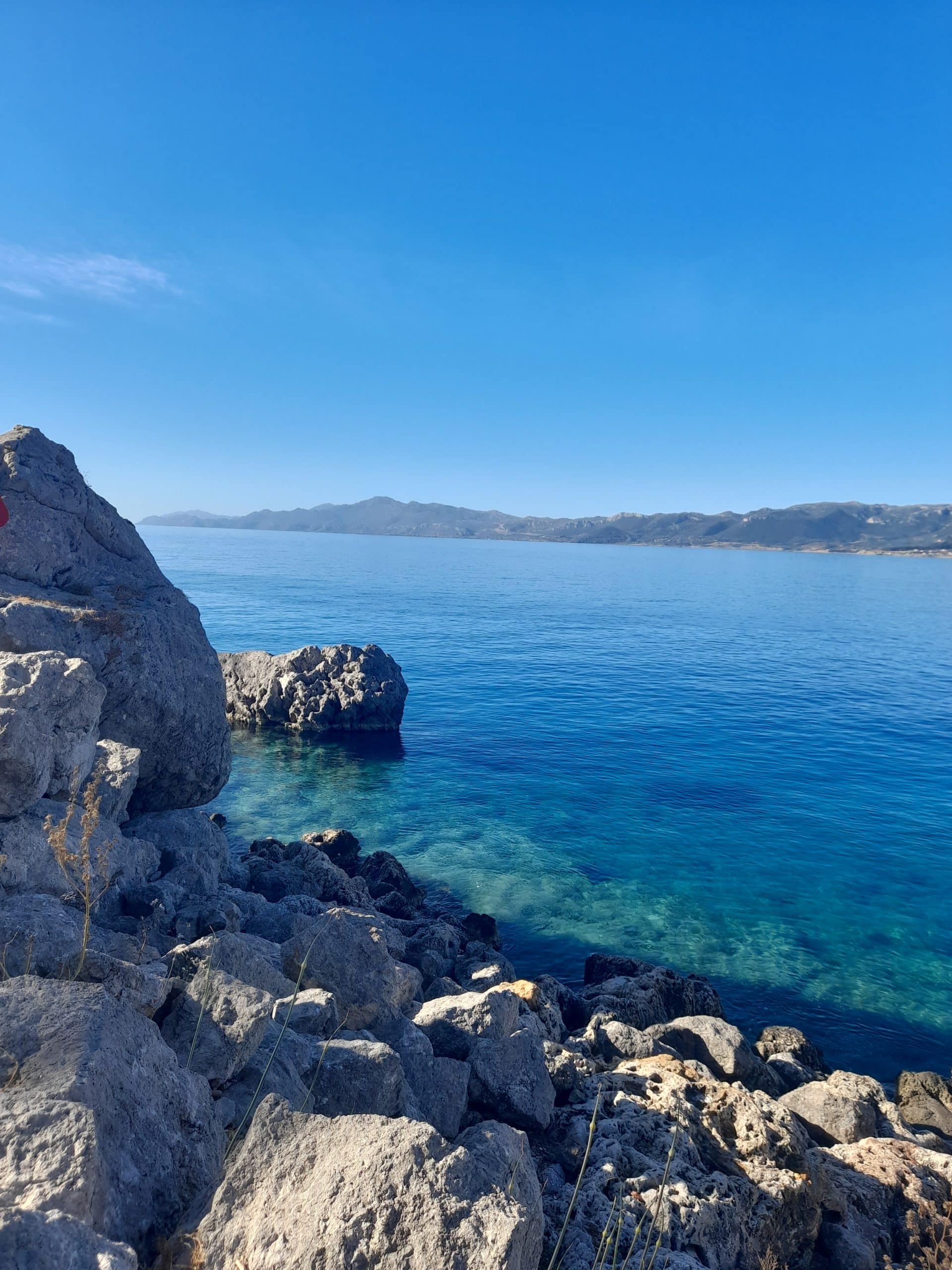
Gefira (Gefyra) village is the little settlement that exists on the mainland, just across the water from Monemvasia. In Greek, Gefira means “bridge” – a fitting name. It is here that you need to travel to in order to reach the manmade land crossing that connects the mainland with old Monemvasia.
The walk from Gefira to the main entrance of medieval Monemvasia takes approximately 25 minutes. Gefira in itself, is quite charming.
Pastelcoloured houses and cafes line the waterfront. Gefira predominantly operates as a fishing village and so, it is possible to enjoy exquisite fresh fish and seafood dishes at many of the tavernas here. In the mornings, you can watch the sunrise as local fishermen sail their boats out to the sea.
There are many hotels, souvlaki spots, restaurants, and tourist stores in Gefira. In the summer months, the village is often crowded with tourists. The accommodation here offers a lower cost alternative to some of the luxe hotels in medieval Monemvasia.
Monemvasia Beach
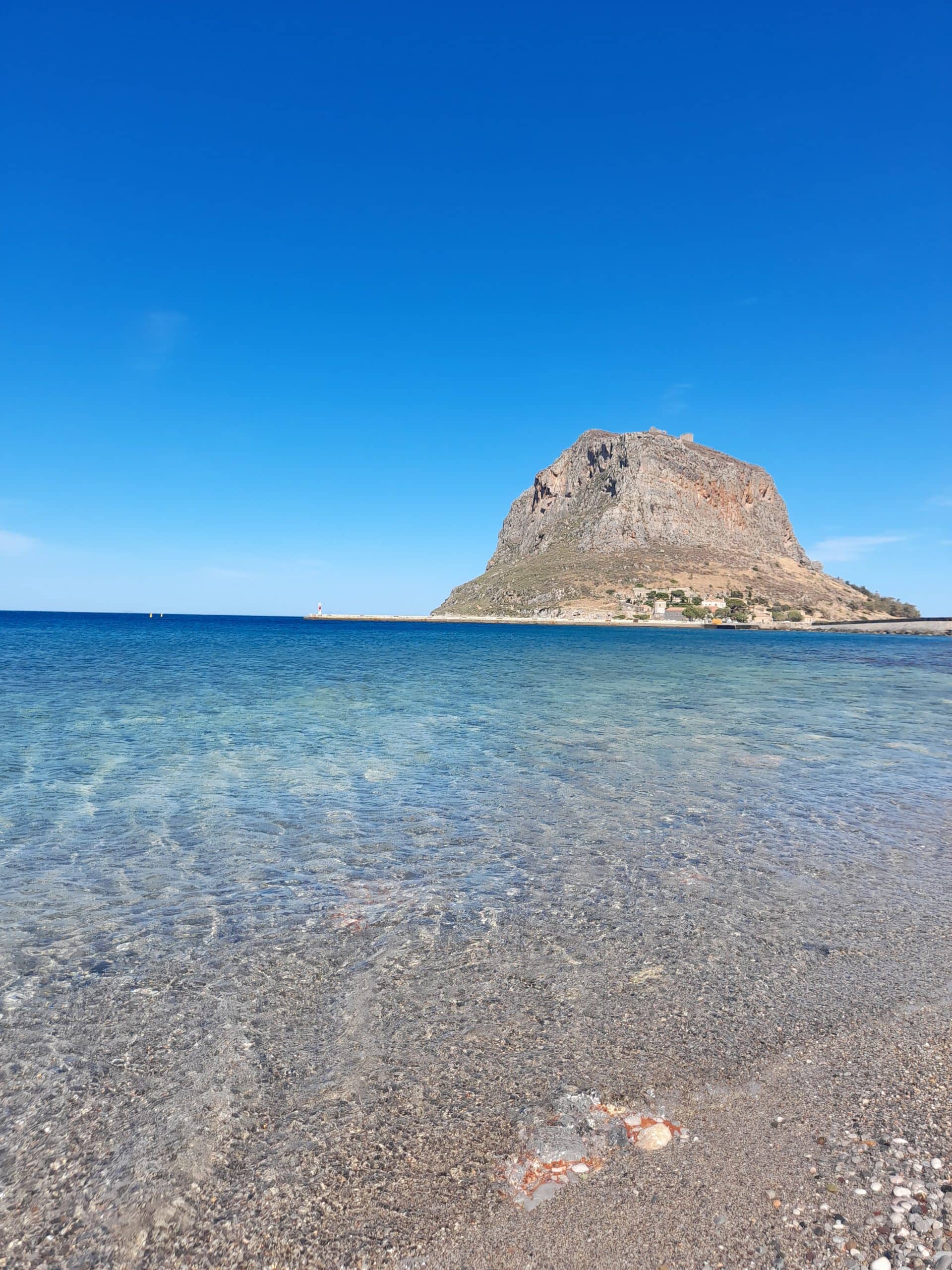
Granted, you don’t come to Monemvasia for its beaches. However, on a hot, humid, Greek summer’s day, this is a pleasant place to relax if you need a little respite from the heat.
The waters here are crystal clear, cerulean, and calm – perfect for swimming in. You can simply lay down your towel and enjoy the pebbled beach, or rent a sunbed from one of the tavernas in Gefira that offer affordable rentals.
What could be a more magical experience than swimming with Monemvasia rock in the background? Monemvasia beach aside, there are several areas around Monemvasia rock where you can descend to the sea for a swim. The nearby beaches of Pori and Xifias are also well worth the drive out to.
Where to Stay in Monemvasia
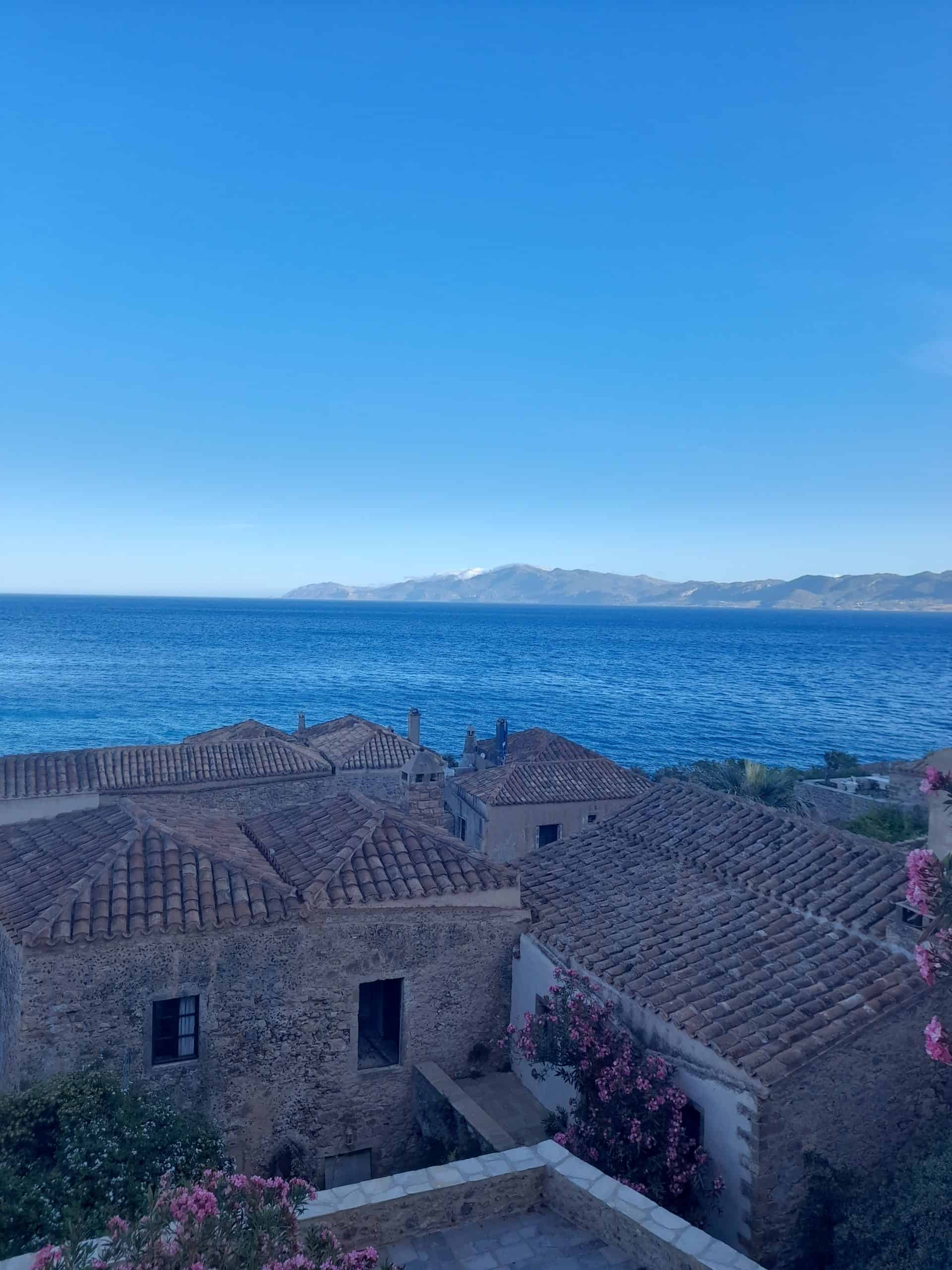
Monemvasia boasts hotels and accommodation options to suit every budget and travel style. Perhaps the best experience is found in staying in the traditional guesthouses housed inside cute stone buildings. Lower cost options can be found in nearby Gefira.
Malvasia Hotel
The Malvasia hotel is situated 300 meters from the castle gate at the end of Monemvasia’s cobbled main street. From its rooms, balconies, and terraces, guests enjoy unparalleled views over the horizon and the Myrtoan sea. The stylish property is set inside seven adjacent stone residential homes that have been lovingly restored.
Rooms at Malvasia Traditional Guesthouse start from around €60 per night and include a generous buffet breakfast. Click here to check the latest rates and availability.
Stellaki Mansion
Stellaki Mansion is one of the oldest and grandest buildings in old Monemvasia. Historically, it has housed some of the town’s most important noble families. Today, it serves as a charming guesthouse.
The mansion is conveniently located just 50 meters from the castle gate, right on the castle walls. The rooms, with their stone walls and wooden ceilings combine ancient tradition with modern style, offering all the amenities needed for a luxurious stay.
Rooms start from €60 per night including breakfast. The latest rates and availability can be found here.
Aktaion Hotel
Aktaion hotel is conveniently located right on the seafront at Gefira. Rooms here start from just €28 a night, making it a great choice for travellers on a budget.
The recently renovated property offers affordable comfort. All rooms have a balcony, air conditioning, flat screen televisions and complimentary toiletries. You can check the latest room rates and availability here.
Where to Eat in Monemvasia
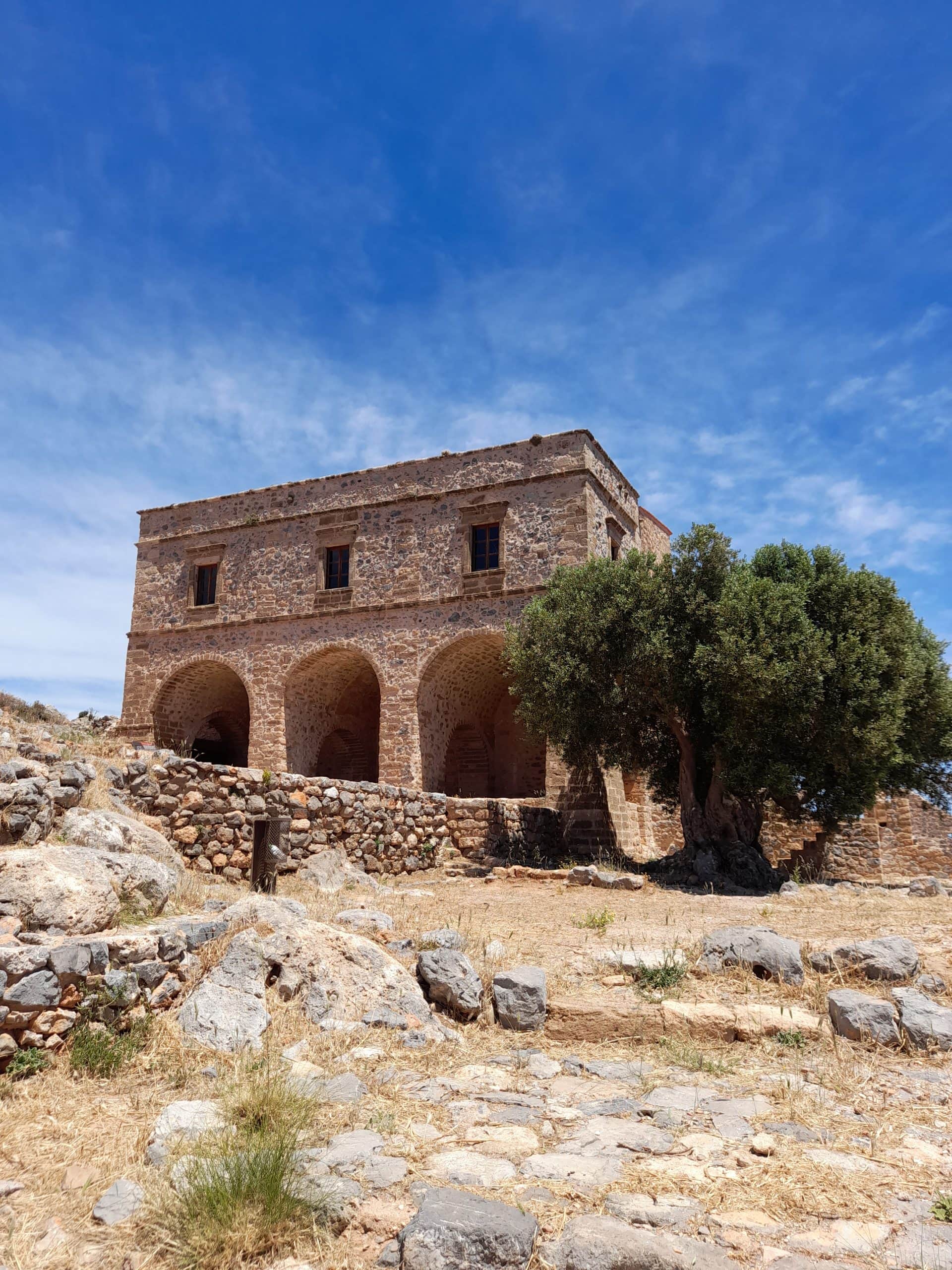
There are many excellent Greek and international dining options available in Monemvasia and Gefira. Their menus boast both Greek classic dishes and Laconia delicacies.
Da Sabatino, Gefira
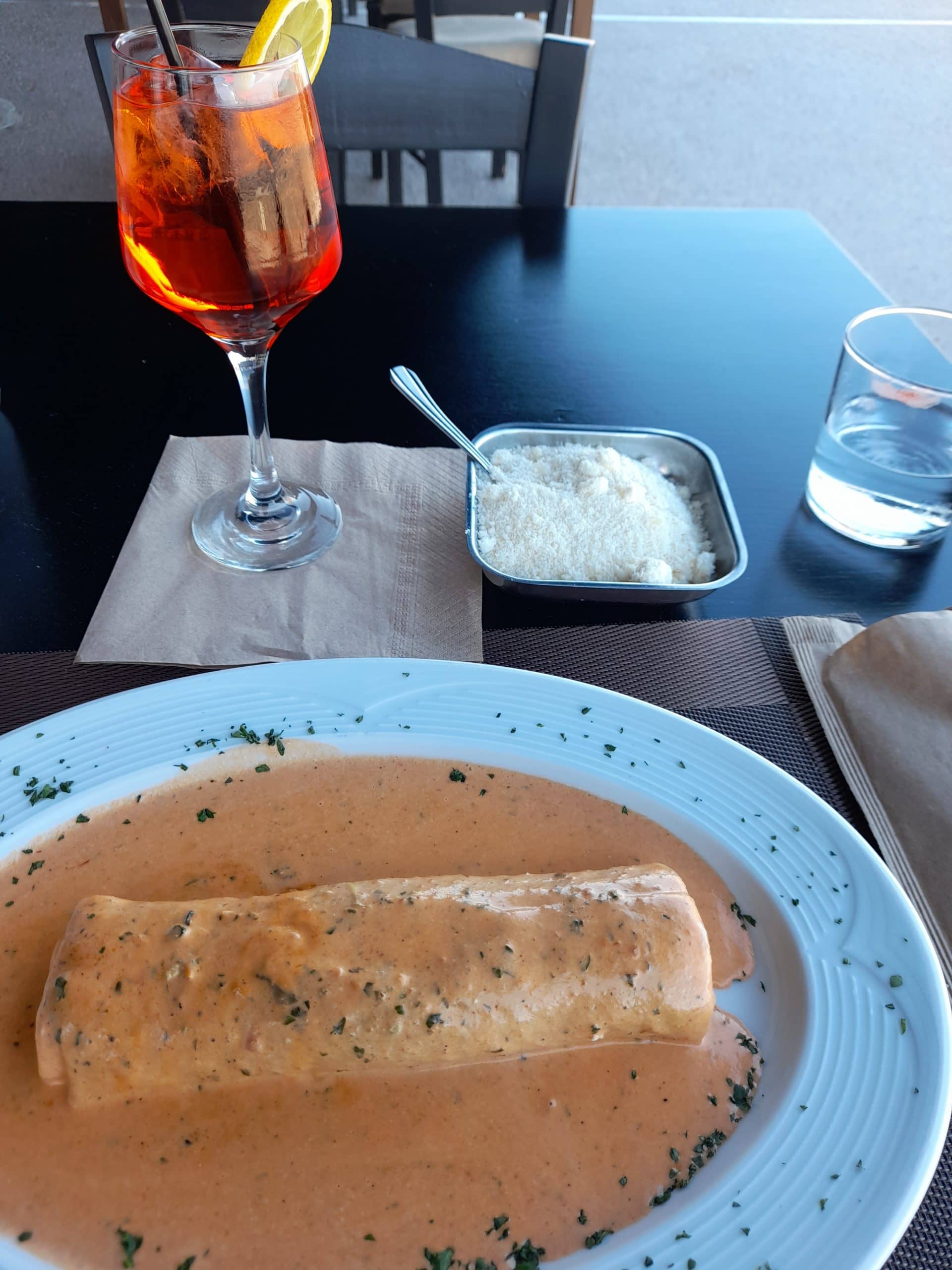
Authentic Italian cuisine can be difficult to find in Greece. Fortunately, it awaits at Da Sabatino on the seafront of Gefira.
Da Sabatino’s chef hails from Naples, Southern Italy. He serves an array of exquisite dishes from across Italy on his menu – exquisite cacio e pepe pasta from Rome, tagliatelle ragù from Bologna, and gnocchi alla Sorrentina from Sorrento.
The food is mouthwatering and the prices are reasonable. Most of the ingredients used to prepare the dishes come from Italy, and an array of Italian wines are also featured on the menu.
To Kanoni
To Kanoni is a highly acclaimed eatery in the central square of Monemvasia. In Greek, “Kanoni” means “cannon”. This is a fitting name considering the restaurant’s location within Monemvasia’s defensive walls, surrounded by old rusting cannons.
To Kanoni focuses their menu offering on highlighting the very best of Peloponnesian cuisine. Quality products are sourced from local farmers and producers in the area surrounding Monemvasia.
The menu changes with the season in order to ensure only the freshest of ingredients. Here, you can opt to enjoy a quintessentially Greek main meal, or a selection of small meze plates.
To Kanoni’s oven, baked lamb kleftiko served with vegetables and graviera cheese is not to miss. Nor are the local smoked sausages hand made with orange rind and sage.
Malvasia Cafe
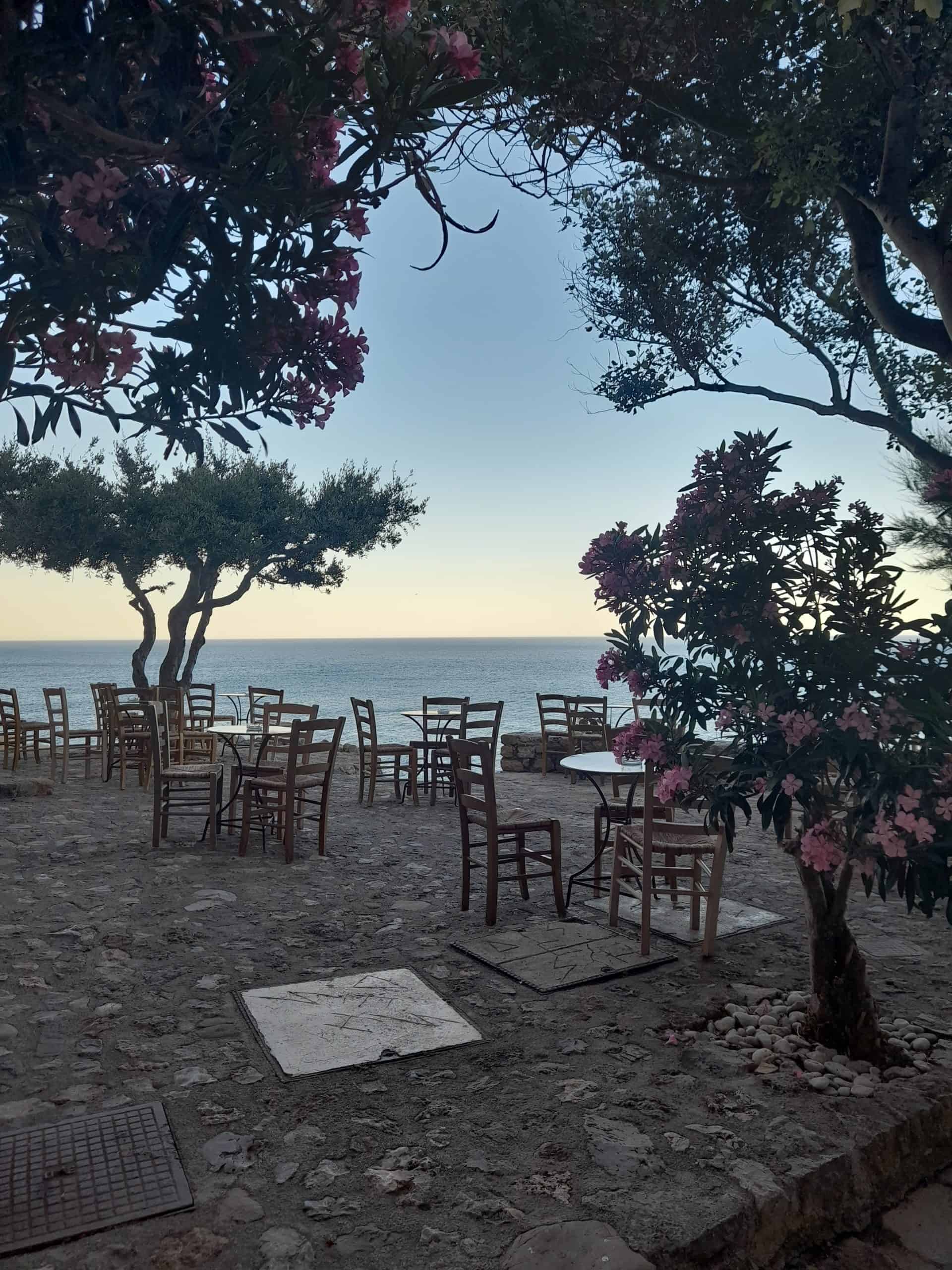
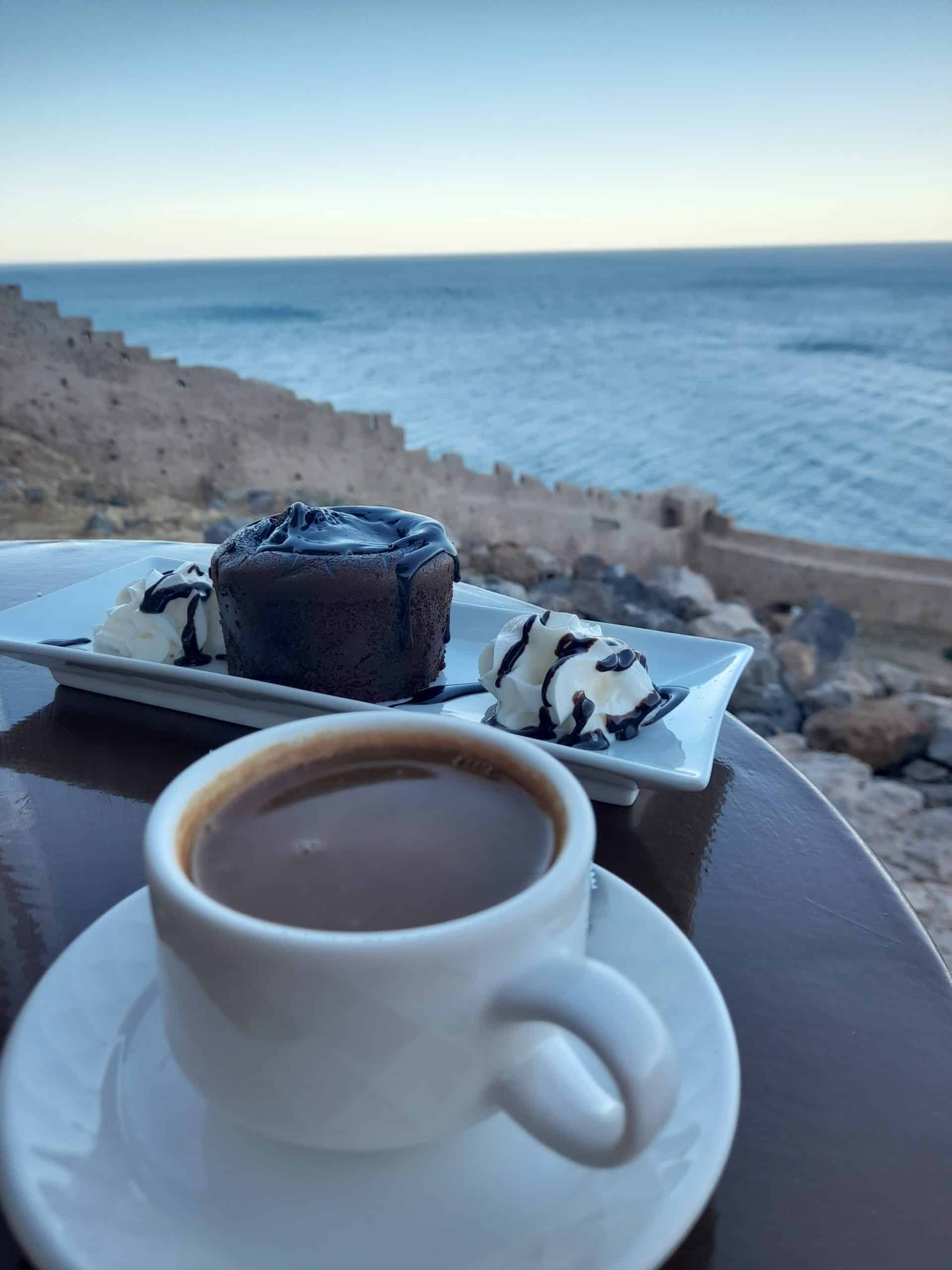
Malvasia Cafe is a charming cafe at the far eastern edge of Monemvasia. This little coffee shop serves an array of snacks, cakes, and desserts. Sitting on the little wicker chairs here, as you look out to the open sea, is the perfect place for enjoying the sunset.
Parting Words
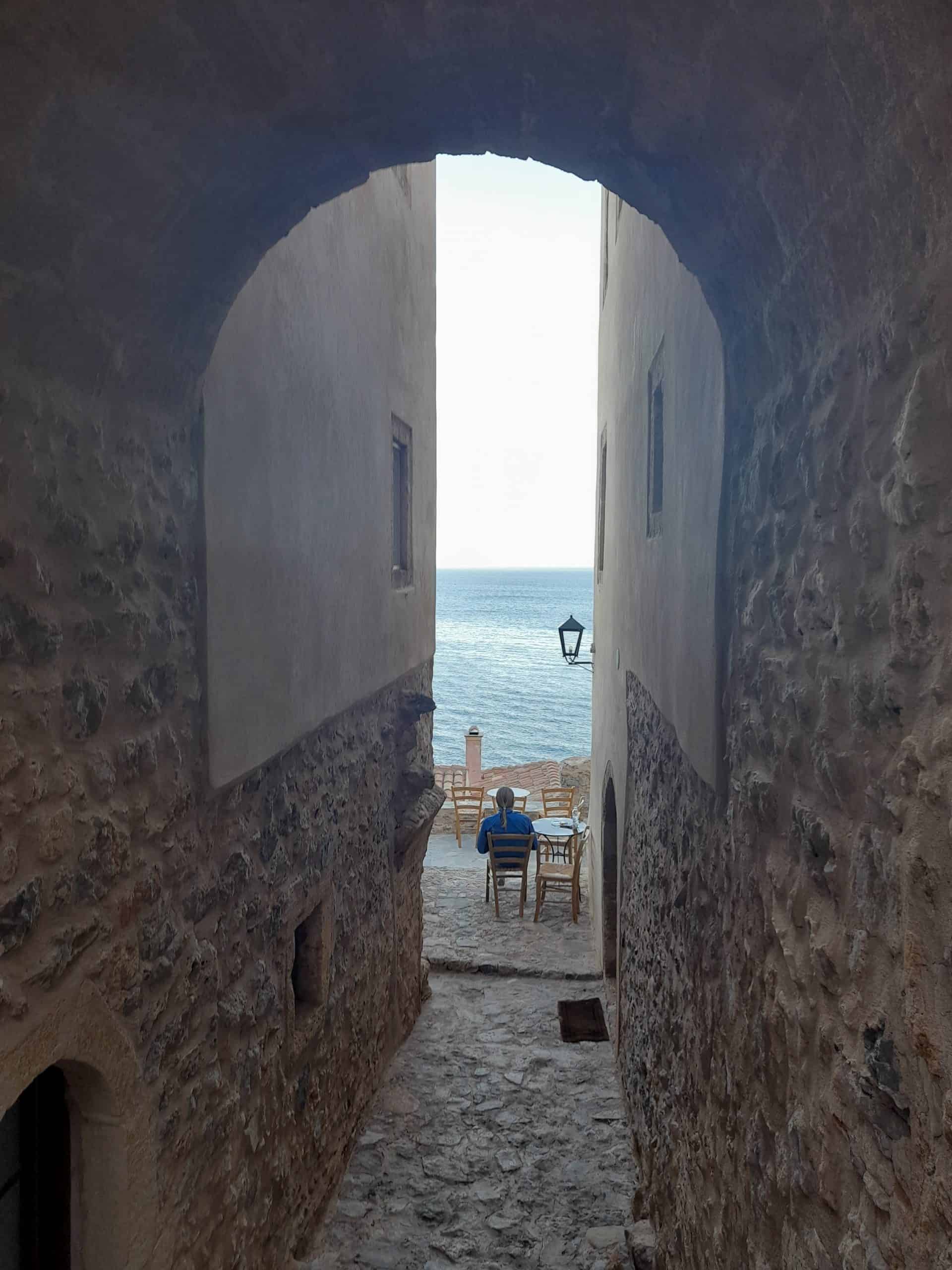
Do you have any additional questions about this Monemvasia Greece travel guide, or drafting out a Greece travel itinerary? Feel free to reach out below.
I have lived in Greece since 2017 and have explored this beautiful country pretty extensively in that time. Please don’t hesitate to drop me a comment if you need anything.
Safe travels! Geia sou! Melissa xo
